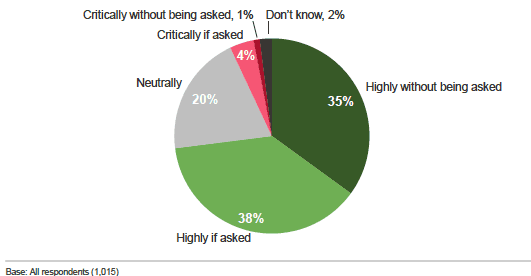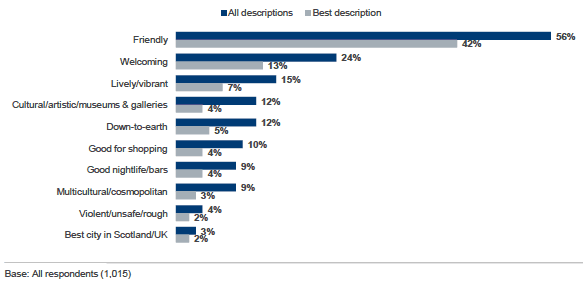The Potential of Existing Cross-Sectional and Longitudinal Surveys to Support the Commonwealth Games 2014 Legacy Evaluation
The review focusses on data sources not already in use in the evaluation (eg in the baseline report or on the Assessing Legacy website) that could shed insight into the extent to which Scotland’s games legacy ambitions are met over time, especially in the areas of sports participation; volunteering; cultural engagement and civic pride.
6. CIVIC PRIDE
Introduction
6.1 The Scottish Government and partner agencies are keen to use the opportunity of the Games to increase national and civic pride and enhance the international reputation of Scotland.
6.2 There is currently a dearth of data on national and civic pride in Scotland that could be used to evaluate progress on this theme, beyond those contained within the British and Scottish Social Attitudes Surveys[17], and the Scottish Household Survey[18]. The small number of measures presented in this chapter comprise a question from the self-completion module of Understanding Society and a module from the most recently published wave of the Glasgow Household Survey (GHS).
Levels of civic pride
6.3 The data from the self-completion module[19] of Understanding Society points towards reasonably strong levels of civic pride in Scotland. Around three-quarters of respondents said that they regularly stopped and talked with people in their neighbourhood and that they would be willing to work together with others to improve something in their neighbourhood. A majority also said that they felt they belonged to their neighbourhood, thought of themselves as similar to other people who lived in their neighbourhood and valued the friendships and associations they had with other people (Table 6.1).
Table 6.1. Civic pride in Scotland, 2010
| Strongly agree/ agree | Neither agree nor disagree | Strongly disagree/ disagree | N | |
|---|---|---|---|---|
| I would be willing to work together with others to improve something in my neighbourhood | 77% | 17% | 6% | 2,945 |
| I regularly stop and talk with people in my neighbourhood | 73% | 16% | 12% | 2,972 |
| I feel like I belong to this neighbourhood | 67% | 25% | 8% | 2,981 |
| I like to think of myself as similar to the people who live in this neighbourhood | 62% | 26% | 12% | 2,964 |
| The friendships and associations I have with other people in my neighbourhood mean a lot to me | 60% | 29% | 10% | 2,965 |
| If I needed advice about something, I could go to someone in my neighbourhood | 55% | 22% | 24% | 2,948 |
| I borrow things and exchange favours with my neighbours | 44% | 22% | 34% | 2,935 |
Source: Understanding Society
6.4 Data from the most recently published wave (autumn 2012) of the GHS are broadly consistent with these findings: around two-thirds (65%) of residents said they felt part of the community in which they lived and an equal proportion said they felt proud of their local area. Almost nine in ten (85%) said they felt proud of Glasgow as a whole.
6.5 Table 6.2 provides a break-down of these results by Community Planning Partnership Area (CPPA)[20]. In the two CPPAs that make up the East of Glasgow (Baillieston, Shettleston & Greater Easterhouse, and East Centre & Calton), levels of belonging and civic pride were in line with the city-wide averages. In most of the other CPPAs, the results were similarly consistent, although it was notable that a higher than average proportion of residents in Central & West said they felt proud of their local area (76% versus 65% overall), compared with a lower than average proportion in Greater Pollok, Newlands & Auldburn (47% versus 65% overall). All of these results should be treated as indicative rather than representative, however, given the small CPPA bases sizes involved.
6.6 Across Glasgow, a higher than average proportion of residents aged 65 years and over felt part of their community (74% versus 65% overall), proud of their local area (77% versus 65% overall) and proud of the city as a whole (93% versus 85% overall).
Table 6.2. Civic pride in Glasgow by CPPA, autumn 2012
| I feel part of the community I live in | I feel proud of my local area | I feel proud of the city of Glasgow | N | |
|---|---|---|---|---|
| All CPPAs | 65% | 65% | 85% | 1,015 |
| East End CPPAs | ||||
| Baillieston, Shettleston & Greater Easterhouse | 65% | 61% | 78% | 101 |
| East Centre & Calton | 71% | 61% | 89% | 101 |
| Other CPPAs | ||||
| Central & West | 62% | 76% | 88% | 104 |
| Govan & Craigton | 68% | 67% | 86% | 101 |
| Greater Pollok, Newlands & Auldburn | 61% | 47% | 85% | 108 |
| Langside & Linn | 65% | 68% | 88% | 99 |
| Maryhill, Kelvin & Canal | 68% | 72% | 86% | 103 |
| North East | 69% | 53% | 90% | 98 |
| Pollokshields & Southside Central | 64% | 62% | 78% | 95 |
| West | 55% | 73% | 83% | 98 |
Source: Glasgow Household Survey
6.7 Reflecting the pride most residents felt for Glasgow as a whole, a majority (73%) said that they would speak highly of the city to people from elsewhere, with around a third saying they would do so without being asked their opinion. Meanwhile, 20% said they would be neutral about the city and just 5% in total said they would be critical of it (Figure 6.1).
Figure 6.1. Advocacy of Glasgow among residents, autumn 2012
Q. Which of these phrases best describes the way you would talk about Glasgow to people from outside the city (e.g. people you meet on holiday)?

Source: Glasgow Household Survey
6.8 Again, the results for the two East End CPPAs were consistent with the city-wide averages, whereas in Central and West, a higher than average proportion of residents said they would speak highly of Glasgow (Table 6.3).
Table 6.3. Advocacy of Glasgow among residents by CPPA, autumn 2012
| Percentage who would speak highly of Glasgow |
N | |
|---|---|---|
| All CPPAs | 73% | 1,015 |
| East End CPPAs | ||
| Baillieston, Shettleston & Greater Easterhouse | 72% | 101 |
| East Centre & Calton | 75% | 101 |
| Other CPPAs | ||
| Central & West | 86% | 104 |
| Govan & Craigton | 68% | 101 |
| Greater Pollok, Newlands & Auldburn | 66% | 108 |
| Langside & Linn | 69% | 99 |
| Maryhill, Kelvin & Canal | 79% | 103 |
| North East | 78% | 98 |
| Pollokshields & Southside Central | 64% | 95 |
| West | 69% | 98 |
Source: Glasgow Household Survey
6.9 Asked which specific words or phrases they would use to describe Glasgow to people from outside the city, around three in five (56%) residents said friendly, while 24% said welcoming and 15% said they would refer to the city's vibrancy or liveliness. Most other words and phrases mentioned related to Glasgow's leisure and cultural credentials - there was a specific focus on the quality of its retail offering, nightlife and museums and galleries (Figure 6.2).
Figure 6.2. Perceived characteristics of Glasgow among residents - top 10 (unprompted) responses, autumn 2012 (excludes 'other' and 'don't know' responses)
Q. Which two or three words or phrases would you use to describe Glasgow to people from outside the city?
Q. Of these, which sums up Glasgow best?

Source: Glasgow Household Survey
6.10 As table 6.4 shows residents in East Centre & Calton, along with those in the West, were more likely than average to say they would describe Glasgow as lively. There were few other CPPA-based differences, although the perception of Glasgow as friendly was most common in Langside & Linn and North East.
Table 6.4. Perceived characteristics of Glasgow among residents by CPPA, autumn 2012
| Friendly | Welcoming | Lively | Cultural | N | |
|---|---|---|---|---|---|
| All CPPAs | 56% | 25% | 25% | 12% | 1,015 |
| East End CPPAs | |||||
| Baillieston, Shettleston & Greater Easterhouse | 45% | 23% | 7% | 11% | 101 |
| East Centre & Calton | 52% | 15% | 25% | 10% | 101 |
| Other CPPAs | |||||
| Central & West | 51% | 25% | 25% | 7% | 104 |
| Govan & Craigton | 62% | 30% | 13% | 15% | 101 |
| Greater Pollok, Newlands & Auldburn | 41% | 15% | 6% | 17% | 108 |
| Langside & Linn | 77% | 29% | 11% | 16% | 99 |
| Maryhill, Kelvin & Canal | 62% | 32% | 14% | 12% | 103 |
| North East | 67% | 27% | 7% | 10% | 98 |
| Pollokshields & Southside Central | 54% | 23% | 16% | 14% | 95 |
| West | 58% | 23% | 22% | 12% | 98 |
Source: Glasgow Household Survey
Conclusions
6.11 It is hoped that pride at both a national and civic level will increase around the time of the Commonwealth Games and be sustained thereafter. There is currently very little relevant data available on national pride in Scotland and so the measures considered in this chapter focused on pride at the neighbourhood, local area and civic level.
6.12 The Understanding Society questions provide a robust, longitudinal measure of different potential indicators of neighbourhood pride but it is not clear that these indicators would be expected to change as a consequence of an event like the Games, even if national or civic pride increased. Quite apart from this, and as discussed in relation to volunteering, Understanding Society includes no questions that assess factors underpinning neighbourhood pride that might allow for an assessment of the impact of the Games in this regard.
6.13 The GHS includes questions that focus more directly and explicitly than those in Understanding Society on residents' level of pride in their area and, as such, arguably provide more relevant data at the city level. But again, the survey includes no questions to assess factors underpinning pride and thus the Games' impact. If possible, we suggest that such a question be added to the GHS module in the future.
6.14 The GHS provides some indicative data on civic pride at the East End level but the base sizes are too small to provide for a robust analysis. Therefore, we recommend adding at least some of the GHS questions to GoWell to provide a source of data on civic pride at this level.
6.15 In Report 1, the Scottish Government outlined plans to collect new data on national and civic pride through a Schools omnibus and an Adult omnibus survey. This will go some way to filling current gaps in the evidence on national and civic pride at the Scotland-level, including among young people. Augmenting the GHS and GoWell questions in the ways suggested will help to ensure that gaps at the Glasgow- and East-End-level are similarly addressed.
Contact
Email: Niamh O'Connor
There is a problem
Thanks for your feedback